Introduction
In the realm of gastronomy, few dishes encapsulate the harmony of contrasting flavors and textures as elegantly as the Cucumber and Pig Heart Salad. This dish, rooted in traditional Chinese cuisine yet adaptable to modern palates, marries the crisp freshness of cucumber with the rich, tender depth of pig heart. Often overlooked in Western cooking, pig heart—a nutrient-dense organ meat—offers a robust flavor profile that, when prepared thoughtfully, transforms into a culinary delight. Paired with the cool, hydrating crunch of cucumber and a zesty dressing, this salad becomes a testament to the art of balance: delicate yet hearty, simple yet sophisticated. This article will guide you through the intricate steps of preparing this dish, from selecting the finest ingredients to mastering the nuances of seasoning. Whether you are a seasoned chef or a curious home cook, this recipe promises to elevate your understanding of offal cuisine and redefine your approach to salad-making.
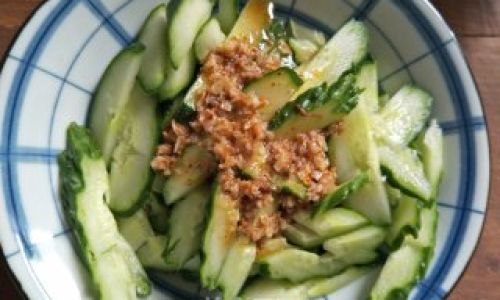
The Philosophy Behind the Dish
At its core, the Cucumber and Pig Heart Salad embodies the Chinese culinary principle of yin and yang—the interplay of opposing forces that create harmony. The pig heart, with its earthy, mineral-rich taste, represents the yang element, providing warmth and substance. The cucumber, with its high water content and mild, refreshing flavor, embodies yin, offering a cooling counterbalance. Together, they form a dish that is both grounding and invigorating, making it an ideal choice for summer meals or as a revitalizing appetizer. Beyond its philosophical underpinnings, this salad is a celebration of frugality and creativity, turning a humble ingredient like pig heart into a gourmet experience.
Ingredients: A Symphony of Flavors
To embark on this culinary journey, gather the following ingredients:
-
For the Pig Heart Preparation:
- 1 fresh pig heart (approximately 500 grams)
- 2 tablespoons white vinegar (for cleansing)
- 1 teaspoon salt (for rinsing)
- 4 cups water (for blanching)
- 3 slices fresh ginger
- 2 green onions, roughly chopped
-
For the Cucumber Base:
- 2 medium English cucumbers (or 3 smaller ones)
- 1 teaspoon salt (for drawing out moisture)
-
Aromatics and Seasonings:
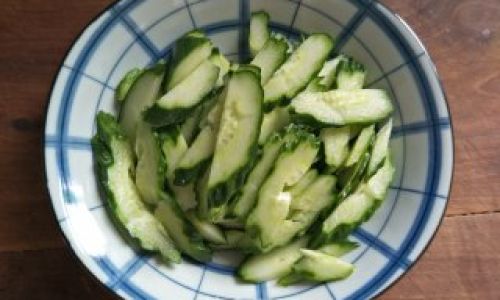
- 3 garlic cloves, minced
- 2 fresh red chili peppers, thinly sliced (adjust to taste)
- 1/4 cup fresh cilantro leaves, chopped
- 1/4 cup roasted peanuts, crushed
- 2 tablespoons sesame oil
- 3 tablespoons light soy sauce
- 2 tablespoons black vinegar (or rice vinegar)
- 1 tablespoon sugar
- 1/2 teaspoon freshly ground black pepper
- Optional: 1 teaspoon chili oil (for heat) or 1 teaspoon toasted sesame seeds (for garnish)
The Preparation Process: Step by Step
Cleaning and Cooking the Pig Heart
The pig heart, though flavorful, requires meticulous cleaning to remove any residual blood or impurities. Begin by trimming away excess fat and connective tissues from the heart’s surface. Rinse it thoroughly under cold water. To eliminate any lingering gamey flavor, soak the heart in a mixture of cold water and white vinegar for 30 minutes. Drain and rinse again.
In a large pot, bring 4 cups of water to a rolling boil. Add the ginger slices and green onions, which will impart a subtle aromatic note. Submerge the pig heart into the boiling water and reduce the heat to a simmer. Allow it to cook for 15–20 minutes, or until the meat is tender but not overly soft. To check doneness, pierce the thickest part with a knife; it should meet slight resistance. Remove the heart from the pot and let it cool on a cutting board. Once cooled, slice it into thin, bite-sized strips.
Preparing the Cucumbers
English cucumbers, with their thin skin and minimal seeds, are ideal for this salad. Slice them lengthwise into ribbons using a vegetable peeler or mandoline, creating delicate, translucent strips. Alternatively, use a sharp knife to cut them into thin, even slices. Place the cucumbers in a colander, sprinkle with salt, and toss gently. Let them sit for 15–20 minutes to draw out excess moisture, which prevents the salad from becoming watery. Rinse the cucumbers under cold water, pat them dry with a kitchen towel, and set aside.
Crafting the Dressing
The dressing is the soul of this salad, harmonizing the ingredients with its umami-rich, tangy profile. In a small bowl, combine the minced garlic, sliced chili peppers, soy sauce, black vinegar, sugar, sesame oil, and black pepper. Whisk vigorously until the sugar dissolves. Taste and adjust the seasoning—add a pinch more sugar for sweetness, a splash of vinegar for acidity, or a drizzle of chili oil for heat. The dressing should be vibrant and well-balanced, with each ingredient shining through without overpowering the others.
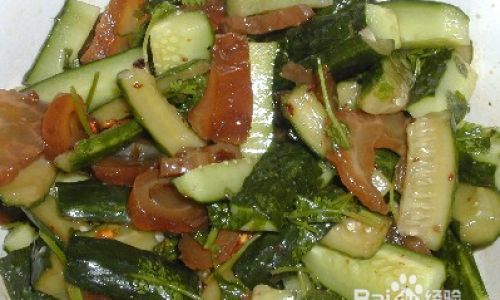
Assembling the Salad
In a large mixing bowl, combine the sliced pig heart and cucumbers. Pour the dressing over the top, using tongs or your hands to toss gently, ensuring every piece is coated. Sprinkle the chopped cilantro and crushed peanuts on top, folding them into the mixture. For an extra layer of texture, toast the peanuts in a dry pan before crushing.
Transfer the salad to a serving platter and garnish with sesame seeds or a drizzle of chili oil, if desired. Let the salad marinate in the refrigerator for at least 30 minutes (or up to 2 hours) to allow the flavors to meld. This chilling period also enhances the cucumbers’ crispness and mellows the heart’s intensity.
Serving Suggestions and Pairings
This salad shines as a standalone appetizer or as part of a multi-course meal. Serve it alongside steamed jasmine rice, cold noodles, or脆皮烤鸭 (crispy roast duck) for a contrast of textures. For a lighter option, pair it with chilled sake or a crisp lager beer. The dish’s versatility also lends itself to creative adaptations: add shredded carrots for sweetness, julienned daikon radish for peppery zing, or diced avocado for creaminess.
The Nutritional Powerhouse
Beyond its culinary appeal, this salad is a nutritional powerhouse. Pig heart is an excellent source of iron, vitamin B12, and Coenzyme Q10, which supports heart health and energy production. Cucumbers, composed of 95% water, hydrate the body while providing antioxidants like vitamin C and beta-carotene. The garlic and chili peppers contribute anti-inflammatory compounds, making this dish as wholesome as it is delicious.
Cultural Context and Modern Adaptations
In Chinese households, offal dishes like this salad are often served during festive occasions or family reunions, symbolizing thriftiness and respect for the whole animal. However, in recent years, chefs and home cooks alike have reimagined such traditional recipes, incorporating global flavors and presentation styles. For instance, a deconstructed version might feature the pig heart seared and served atop cucumber ribbons, drizzled with a wasabi-soy emulsion.
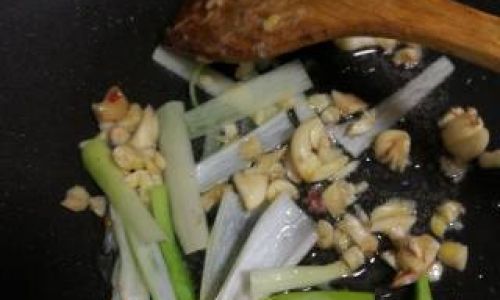
Troubleshooting and Tips
- Tough Pig Heart: Overcooking can render the heart chewy. Simmer gently and test for doneness early.
- Bland Flavor: Ensure the dressing is adequately seasoned. Taste and adjust before assembling.
- Soggy Cucumbers: Salting and rinsing are crucial steps to remove excess moisture.
- Spice Level: Adjust chili quantities based on preference. For a milder version, omit the seeds.
Conclusion
The Cucumber and Pig Heart Salad is more than a dish—it is a narrative. It tells the story of culinary ingenuity, where humble ingredients are elevated through skill and creativity. By mastering this recipe, you gain not just a meal but an appreciation for the alchemy of flavors and textures. Whether you seek to impress dinner guests or simply savor a plate of wholesome goodness, this salad invites you to explore the boundaries of your palate. So, roll up your sleeves, sharpen your knife, and embark on a journey that transcends the ordinary. After all, the most memorable dishes are those that dare to be different.



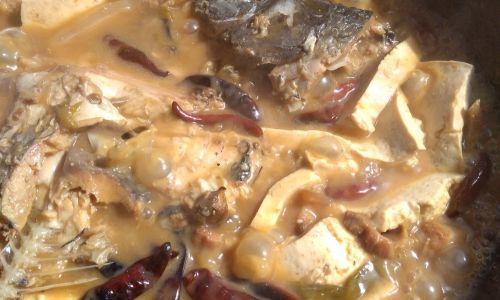
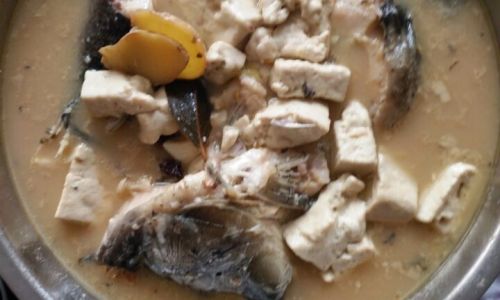
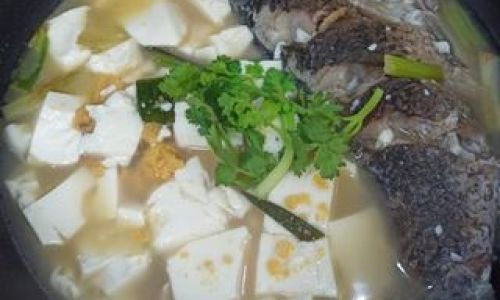
0 comments